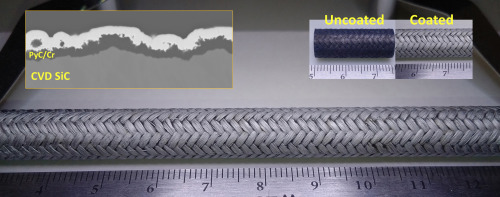Journal of Nuclear Materials ( IF 3.1 ) Pub Date : 2018-03-06 , DOI: 10.1016/j.jnucmat.2018.03.009 Caen Ang , Craig Kemery , Yutai Katoh

|
Electroplating Cr on SiC using a pyrolytic carbon (PyC) bond coat is demonstrated as an innovative concept for coating of advanced fuel cladding. The quantification of coating stress, SEM morphology, XRD phase analysis, and debonding test of the coating on CVD SiC and SiCf-SiC is shown. The residual tensile stress (by ASTM B975) of electroplated Cr is > 1 GPa prior to stress relaxation by microcracking. The stress can remove the PyC/Cr layer from SiC. Surface etching of ∼20 μm and roughening to Ra > 2 μm (by SEM observation) was necessary for successful adhesion. The debonding strength (by ASTM D4541) of the coating on SiC slightly improved from 3.6 ± 1.4 MPa to 5.9 ± 0.8 MPa after surface etching or machining. However, this improvement is limited due to the absence of an interphase, and integrated CVI processing may be required for further advancement.
中文翻译:

通过PyC相容涂层在CVD SiC和SiC f -SiC先进熔覆层上电镀铬
使用热解碳(PyC)粘结涂层在SiC上电镀Cr被证明是一种用于先进燃料包壳涂层的创新概念。显示了在CVD SiC和SiC f -SiC上的涂层应力的量化,SEM形态,XRD相分析和涂层的脱粘测试。电镀铬的残余拉伸应力(根据ASTM B975)> 1 GPa,然后通过微裂纹消除应力。应力可以从SiC去除PyC / Cr层。约20μm的表面蚀刻并粗糙化至R a > 2μm(通过SEM观察)对于成功粘合是必要的。经过表面蚀刻或机械加工后,SiC涂层的剥离强度(根据ASTM D4541)从3.6±1.4 MPa略微提高到5.9±0.8 MPa。但是,由于缺乏中间相,因此这种改进受到限制,并且可能需要集成的CVI处理才能进一步发展。



























 京公网安备 11010802027423号
京公网安备 11010802027423号